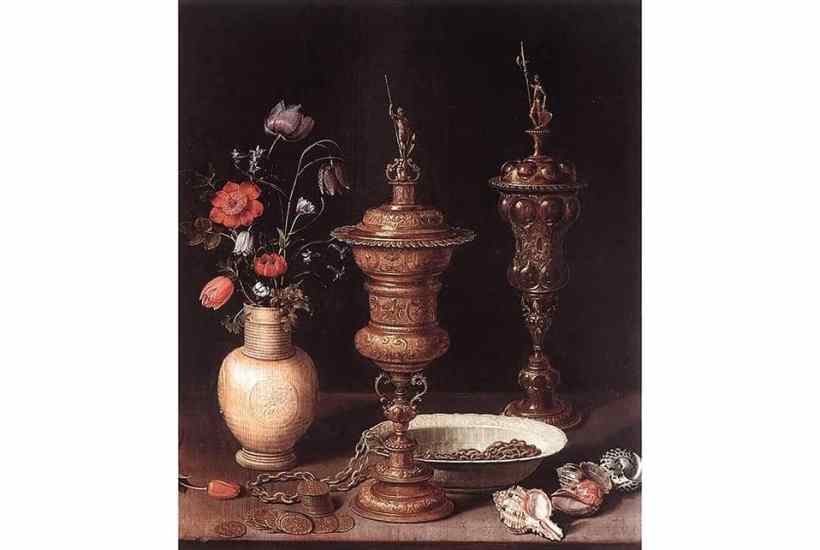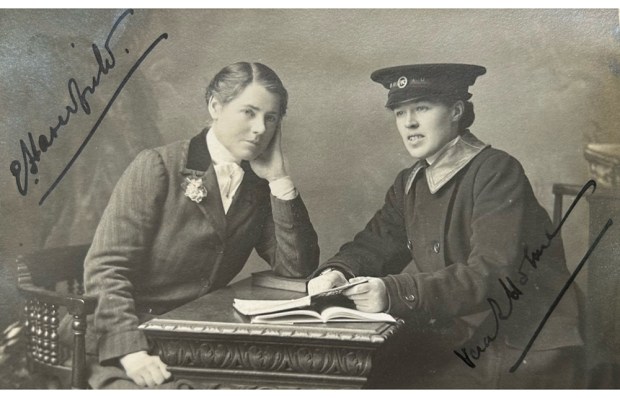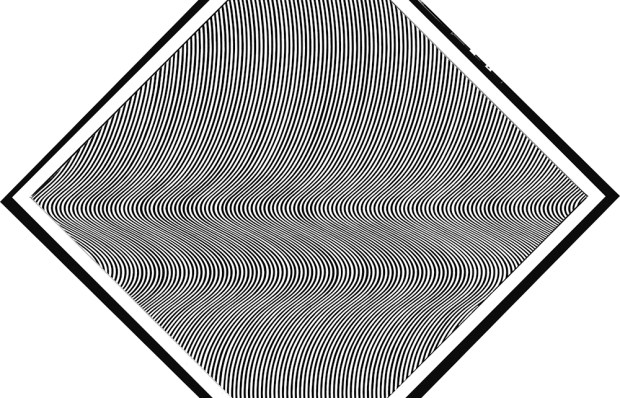At first glance, Clara Peeters’s ‘Still Life with a Vase of Flowers, Goblets and Shells’ (1612) appears to be just that. Carefully arranged on a wooden tabletop, the collected objects are in conversation, the nubby curves of the shells echoing the ribbed neck of the stone vase, their dusky and rosy hues matching the open and squeezed shut buds. But look closer at the gleaming gilt goblet on the right and you’ll notice that the Flemish artist has smuggled tiny self-portraits into the polished roundels – a clever bid to avoid the misattribution of her painting to a man, perhaps, and a form of self-assertion in the male-dominated art world.
Peeters is one of very many women celebrated in the art historian and presenter Katy Hessel’s The Story of Art Without Men, a rallying cry that borrows its title from a regular feature on the reading list of undergraduate art history students: E.H. Gombrich’s The Story of Art. ‘It’s a wonderful book, but for one flaw,’ writes Hessel. ‘His first edition (1950) included zero women artists, and even the 16th edition includes only one.’ Other mind-boggling statistics reeled off in the early pages of her vital companion piece include the percentage of women artists who currently make up the collection of the National Gallery in London: also only one.
Hessel’s aim is both to ‘create a new guide’ and to ‘supplement what we already know’. Her take on the story of art stretches from the 1500s to the present and is divided into five parts that focus on major moments. She isn’t the first to demand a revision of the male-ordered narrative, as she acknowledged in 2015 when she founded her popular Instagram account @thegreatwomenartists and named it after the ground breaking art historian Linda Nochlin’s passionate and provocative essay Why Have There Been No Great Women Artists?, published in 1971. But Hessel is among the few who have offered a sweeping panorama.
She moves beyond the outdated view of women as ‘the wife of, muse of, model of’, and situates them within their social and political context. Take the Renaissance. Its women were hobbled by a lack of resources, training and financial freedom. How did they get around this? ‘Essentially,’ writes Hessel, we can safely assume with disdain, ‘women had to have a powerful man (which might include God) looking after their interests.’ When she entered a nunnery at the age of 14, Plautilla Nelli acquired the skills to paint large-scale altarpieces by studying drawings by the Italian artist Fra Bartolomeo. Elisabetta Sirani learned her practice in her father’s studio and took over when he was incapacitated by gout.
Focusing on any one group risks encouraging further division, and Hessel recognises that several of her subjects would balk at the idea of being categorised as ‘women artists’. Nevertheless, she thinks the term – ‘deemed derogatory’ in times past – is now ‘an embodiment of power’:
It’s not that I believe there to be anything inherently ‘different’ about work created by artists of any particular gender; it’s more that society and its gatekeepers have always prioritised one group in history.
As for the male-shaped hole: ‘It feels important to remove the clamour of men in order to listen carefully to the significance of other artists to our cultural histories.’
The book is crowded, which inevitably means that some artists are only mentioned in passing. But the passion with which Hessel charts the originality, talent and daring of so many trailblazing women makes up for the congestion. Staying true to her aim back in 2015, she maintains ‘an accessible style’, and her easy-going, unfussy approach will surely appeal to art historians and novices alike.
Included are her personal favourites (especially the great 20th-century figurative painter Alice Neel) and feelings – for example about encountering a sculptural work by Eva Hesse:
In my experience, Hesse allows you to see the body without giving you a body at all, and her visceral, fleshy latex and rubber materials, and chaotic and awkward compositions, leave me questioning – is it decaying, or is it living?
Later chapters include quotes from artists practising in the more inclusive yet still skewed world we inhabit today.
Together we marvel at how Emily Mary Osborn used her paintings to critique setbacks during women’s suffrage, and Emma Amos explored black domestic life during the civil rights era. How Gillian Wearing makes us see the familiar afresh and Wangechi Mutu sparks discussions about the sexualisation of the body. How, like the lone tulip that has broken free from the stone vase in her still life, Peeters paved her own path, subverting the genre available to her and stating her identity as an artist.
There’s still some way to go until the gender imbalance is totally redressed, but The Story of Art Without Men, which describes how women achieved artistic excellence against colossal odds, has firmly cracked open the canon.
Got something to add? Join the discussion and comment below.
Get 10 issues for just $10
Subscribe to The Spectator Australia today for the next 10 magazine issues, plus full online access, for just $10.
You might disagree with half of it, but you’ll enjoy reading all of it. Try your first month for free, then just $2 a week for the remainder of your first year.














Comments
Don't miss out
Join the conversation with other Spectator Australia readers. Subscribe to leave a comment.
SUBSCRIBEAlready a subscriber? Log in